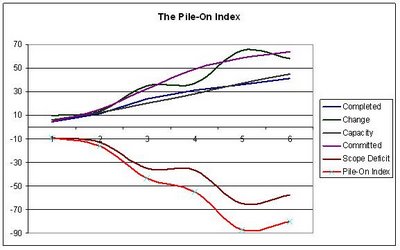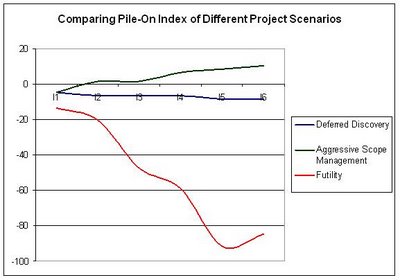Frank Williams, the legendary principal of WilliamsF1Team, has a single question he asks of any proposed change or innovation: “Does it make the car go faster.” This is intuitively appealing, especially for Formula1 teams which are in the business of winning races. We can similarly define a “litmus test” for business decisions: does any given project, initiative or decision make more money for the business?
While it’s great to have an over-riding sense of priority, this isn’t sufficient. We can engineer a car that will sit on pole and lead the race, but if the engine melts or the suspension buckles or the wings fall off after 20 laps, being fast simply isn’t enough. In Formula 1, reliability is just as important as speed for winning races. And the results reflect this: in the November 2006 issue, F1 Racing magazine published an analysis of race results between 2000 and 2006.1 They concluded that Kimi Räikkönen lost two F1 driver’s championships because of reliability problems of his Mclaren-Mercedes; all other things being equal, in 2003 and again in 2005, mechanical retirements cost Kimi a championship. Clearly, going fast is important, but going fast while meeting requirements for quality is another.
The “it makes the car go faster” question is the classic “they get results” statement in consuming business services or solutions. Simply making the car “go faster” at best assumes things are in compliance with expectations (regulatory, quality, security, etc.), at worst dismisses if not outright ignores the importance of these issues relative simply to achieving bottom-line results. In F1, it is important to say that teams are not in the business of “speed,” but of “winning races.” This latter definition is far more inclusive, providing more comprehensive consideration for what it takes to succeed given operating realities.
Just as the FIA is increasing regulation, businesses are subjected to both increasing regulation and expectation (e.g., “is consumer data is secure”). This will affect our business “litmus test:” we can do things that drive revenue or increase profitability, but at what cost to our competitiveness relative to the business environment in which we operate? For example, we can produce a new consumer website to drive revenue, but if there’s a 90% chance of identity theft resulting from its use, the solution is a failure. Similarly, we can cut salaries 10%, but if turnover jumps to 50%, we will have a long-term cost problem. To be competitive, then, in business, just as in F1, we must have a more complete definition of “competitiveness” than simply, “does it make us more money.”
Carrying on with the F1 example, suppose that the FIA changes regulations so that engines must be more “green,” or consume less energy. Should this happen, the question “does it make the car go faster” must be considered with not just reliability but emission constraints, giving us a multi-dimensional problem. Success in this environment is far more difficult than simply “going really fast.”
It is important that we use the word “constraints” as opposed to “considerations” to describe the environment. “Constraints” promotes the value of one dimension over others, in this case “speed” over “reliability” and “emissions.” Emissions and reliability can only lose the race for us (e.g., by being in clear violation of sporting regulations and being disqualified, or by retiring from the race due to insufficient tolerance to stress), whereas speed can win the race for us by putting us, and keeping us, at the front of the grid.
The business imperative, then, regardless of what it means to have a “complete solution” remains the same: we’re in business to make money, not to comply with regulations. However, we respect the fact that we must comply with the regulations, expectations and constraints of the business environment and we place value in our capability to manage in the complete definition of our environment. We therefore want simple yet consistent models through which we can expose, analyze, and improve that which we do such that we maximize results given constraints of our operating environment.
This is why IT governance is such an important capability: it gives us greater mastery over our selves, our environment and how we interact with our environment. To that end, the equivalent question we must ask is “does it make the car more competitive.” This is less appealing as it lacks the precision, exactness and simplicity of “does it make the car go faster.” It also makes our objective a bit more vague, with “regulation” and “expectation” soft qualifiers that introduce opinion into our assessments of “compliance with expectations.” But it is a more accurate definition of success.
And therein lies the governance gap. We’re not especially good at governance now. For one thing, our bias is toward the appearance of results (delivering something under budget, getting something in production, steering systems through transactional acceptance, etc.) over solution completeness. For another, day after day we deal with the self-inflicted wounds of security violations, spiraling maintenance costs, production failures, and so forth. The intensity of the competitive environment – both regulatory and expectation – is only going to increase. We need greater mastery over not just what but how we do such that we’re aware of and developing our capabilities, and actually delivering, complete solutions.
An improved governance capability has the following characteristics:
- We balance our results orientation with a genuine concern for the means by which those results are achieved.
- We embrace a governance model that gives a comprehensive definition of “complete solution” the peer status – but not disproportionate priority – relative to “bottom line results.”
- We have the capability to answer both “effectiveness” and “completeness” questions such that governance is far more a matter of fact than opinion.
- We do the things necessary so that the team can put itself and the car (e.g., the business) on the limit without self-inflicting failure in the form of disqualification or inadequacy.
- We recognize that our ability to govern, as well as our ability to execute, are each maturing aspects of our collective capability; we execute to both as means by which to continuously improve and, therefore, maximize profitability given a changing operating environment.
By so doing, we constantly improve our execution and awareness of our execution, and sharpen our focus in pursuit of what matters most: not running the fastest race we can, but winning the race.
And that’s why we’re in business.
1 The race results analysis appears in the “Looking Back in Anger” column of the Pitpass section of the November 2006 edition of F1 Racing magazine. F1 Racing consistently presents as complete a picture of an industry as you’ll find anywhere, including driver, engineering, supplier, regulatory and management dimensions. They communicate in a matter-of-fact writing style supplemented with unbelievable photographic images. If you have even a passing interest in F1, read a few editions and abstract the lessons learned, you’ll find a take-away for your business or industry.

